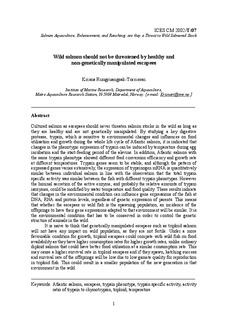| dc.contributor.author | Torrissen, Krisna Rungruangsak | |
| dc.date.accessioned | 2012-10-29T19:41:43Z | |
| dc.date.available | 2012-10-29T19:41:43Z | |
| dc.date.issued | 2002 | |
| dc.identifier.citation | This report is not to be cited without prior reference to the author | no_NO |
| dc.identifier.uri | http://hdl.handle.net/11250/106351 | |
| dc.description.abstract | Cultured salmon as escapees should never threaten salmon stocks in the wild as long as they are healthy and are not genetically manipulated. By studying a key digestive protease, trypsin, which is sensitive to environmental changes and influences on food utilisation and growth during the whole life cycle of Atlantic salmon, it is indicated that changes in the phenotypic expression of trypsin can be induced by temperature during egg incubation and the start-feeding period of the alevins. In addition, Atlantic salmon with the same trypsin phenotype showed different feed conversion efficiency and growth rate at different temperatures. Trypsin genes seem to be stable, and although the pattern of expressed genes varies extensively, the expression of trypsinogen mRNA is quantitatively similar between individual salmon in line with the observation that the total trypsin specific activity was similar between the fish with different trypsin phenotypes. However the luminal secretion of the active enzyme, and probably the relative amounts of trypsin isozymes, could be modified by water temperature and food quality. These results indicate that changes in the environmental condition can influence gene expressions of the fish at DNA, RNA and protein levels, regardless of genetic expression of parents. This means that whether the escapees or wild fish is the spawning population, an incidence of the offsprings to have their gene expressions adapted to that environment will be similar. It is the environmental condition that has to be conserved in order to control the genetic structure of animals in the wild.
It is naive to think that genetically manipulated escapees such as triploid salmon will not have any impact on wild population, as they are not fertile. Under a more favourable condition for growth, triploid escapees could compete with wild fish on food availability as they have higher consumption rates for higher growth rates, unlike ordinary diploid salmon that could have better food utilisation at a similar consumption rate. This may cause a higher survival rate in triploid escapees and if they spawn, hatching success and survival rate of the offsprings will be low due to low gamete quality for reproduction in triploid fish. This could result in a smaller population of the new generation in that environment in the wild. | no_NO |
| dc.language.iso | eng | no_NO |
| dc.publisher | ICES | no_NO |
| dc.relation.ispartofseries | ICES CM Documents;2002/T:7 | |
| dc.subject | farmed fish escape | no_NO |
| dc.subject | fiskerømning | no_NO |
| dc.subject | wild salmon | no_NO |
| dc.subject | villaks | no_NO |
| dc.subject | genetics | no_NO |
| dc.subject | genetikk | no_NO |
| dc.title | Wild salmon should not be threatened by healt and non-genetically manipulated escapees | no_NO |
| dc.type | Working paper | no_NO |
| dc.subject.nsi | VDP::Agriculture and fishery disciplines: 900::Fisheries science: 920::Resource biology: 921 | no_NO |
| dc.subject.nsi | VDP::Agriculture and fishery disciplines: 900::Fisheries science: 920::Fish health: 923 | no_NO |
| dc.source.pagenumber | 16 s. | no_NO |
